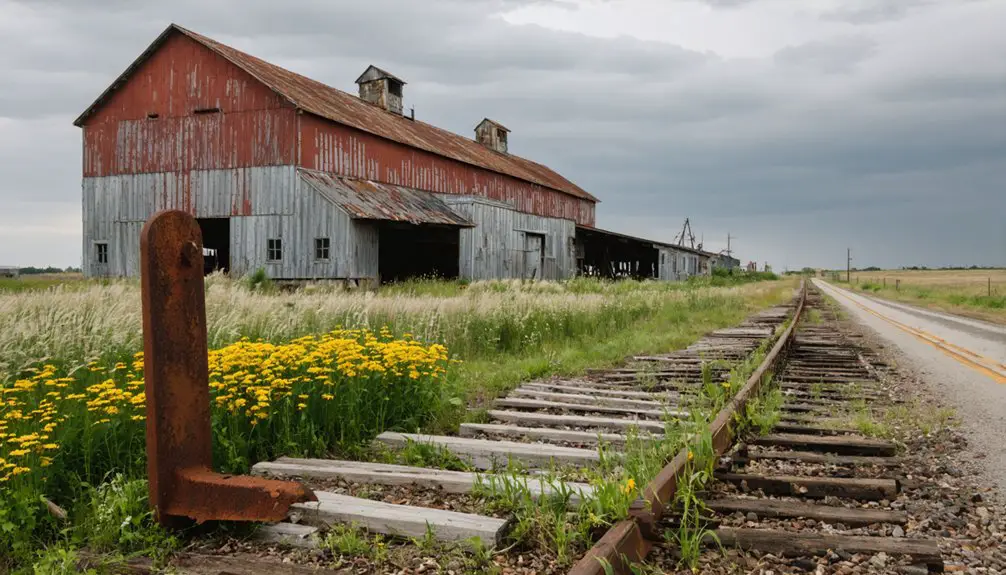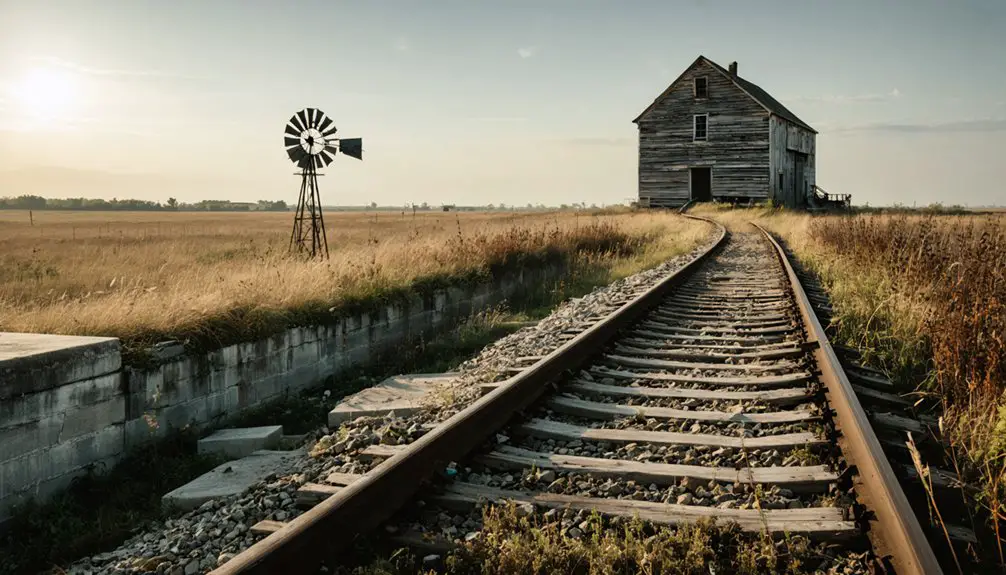You’ll discover Lewisville’s abandoned foundations along the Minnesota River, where this settlement thrived from 1855 until the late 1800s. Once a bustling river trading post with hardware stores, sawmills, and distilleries, the town declined after being bypassed by the Southern Minnesota Railroad in 1868. Nature has since reclaimed the townsite, with forests overtaking streets and seasonal weather eroding structures. Archaeological work has revealed three distinct structural footprints that tell a deeper story of pioneer life.
Key Takeaways
- Lewisville was a Minnesota River settlement that thrived on riverboat commerce before declining due to being bypassed by the Southern Minnesota Railroad.
- The town’s economic foundation included sawmills, blacksmith shops, and general stores before its eventual abandonment and transformation into a ghost town.
- Archaeological work has revealed three distinct structural footprints, confirming both Native American activity and European-American settlement patterns.
- Nature reclaimed the townsite through ecological succession, with vegetation overtaking streets and wildlife populations increasing as human presence diminished.
- The Scott County Historical Society maintains records of Lewisville’s history, with visible homestead foundations still present in Louisville Township’s swamp areas.
The Birth of a River Settlement
While the Snake River Valley desert initially seemed an unlikely place for settlement, its abundant natural resources made it an attractive destination for early inhabitants.
You’ll find that the river geography played a vital role, with dry river beds providing natural pathways for pioneers moving into the region. The land’s diverse wildlife, including elk and deer, along with reliable water sources, supported both indigenous populations and incoming settlers. Many early settlers faced dangers similar to the Urbans, who experienced attacks from Dakota Indians during Minnesota’s frontier period.
The settlement dynamics were shaped by families like the Ellsworths and Jardines, who’d left Utah seeking new opportunities. Limited land and water in their home state of Utah forced them to look elsewhere for viable farming prospects.
Letters from relatives near Poole’s Island sparked interest in northward expansion, while railroad contracts in 1882 gave settlers a chance to survey potential farmland. This combination of family networks and economic opportunities drove the area’s transformation from sagebrush plains to agricultural community.
Life Along the Minnesota River
You’d find settlers along the Minnesota River engaged in a complex web of trade, where local agriculture products flowed downstream while manufactured goods made their way upstream via flatboats and keelboats.
During the river’s boom days, the waterfront buzzed with activity as farmers brought their grain to riverside mills and trading posts exchanged furs for essential supplies. Some confusion arose as multiple place names often referred to different riverside settlements. The devastation of grasshopper plagues in 1878 forced many farmers to abandon their land and seek opportunities elsewhere.
Your daily life by the river would’ve involved fishing, maintaining riverside gardens, and participating in the communal work of loading and unloading boats that connected these frontier settlements to larger markets.
River Trade Boom Days
During the peak years of Lewisville’s existence, the Minnesota River served as the town’s economic lifeline, transforming it into a bustling hub of commercial activity.
You’d find riverboat commerce thriving as vessels transported grain, lumber, and merchandise to and from the settlement. Hardware stores and general merchandise shops quickly sprang up to meet the demands of settlers and farmers, while hotels welcomed merchants and river workers.
The town’s prosperity was marked by seasonal celebrations like Twine Day, when you’d see farmers gathering to stock up on harvest supplies. Like Dallas’s early days as a trading post settlement, Lewisville served as a vital marketplace for incoming migrants and traders.
Commercial buildings and infrastructure expanded rapidly to support the growing trade, with establishments like Richard Jones’ hardware store and Hinton’s general store becoming essential community fixtures.
This river-based economy shaped the town’s development until railroads eventually took prominence.
Settlers’ Daily Riverside Activities
As settlers established their lives along the Minnesota River, daily routines centered heavily on the waterway’s resources and accessibility.
You’d find families performing river chores like fetching water for cooking and cleaning, while women gathered at the riverbanks to wash laundry using washboards and homemade soap. These laundry sessions often doubled as social gatherings where news spread among neighbors.
Fishing practices proved essential for survival, with settlers using nets and lines to catch catfish, pike, and bass. Similar to how five cotton gins once operated in early Lewisville settlements, the river supported multiple fishing operations to sustain the community.
You could spot them harvesting ice in winter months for food preservation, gathering wild plants along the shores, and traveling by canoe or raft between settlements.
The river wasn’t just for work – it served as a recreational hub where children swam, families picnicked, and communities celebrated together.
Economic Rise and Industrial Growth
The economic foundation of Lewisville emerged from northeastern Minnesota’s rich iron ore deposits in the early 1900s, sparking a period of rapid industrial development.
Much like Nininger’s 1,000 residents, Lewisville’s population grew substantially during its peak years.
The town’s economic diversification quickly expanded beyond mining to create a robust industrial ecosystem. Research reveals that historic ruins still offer glimpses into the town’s former prosperity. You’ll find evidence of the town’s industrial resilience in its multi-faceted economy that included:
- Bustling sawmills processing local timber for construction and export
- Essential blacksmith shops serving both mining and lumber operations
- General stores and hotels supporting the growing workforce
- Distilleries and specialty shops meeting diverse community needs
The town’s growth seemed promising, but without a railroad connection, Lewisville struggled to maintain its competitive edge.
As natural resources depleted and larger regional competitors emerged, the town’s industrial base gradually eroded, setting the stage for its eventual transformation into farmland.
Transportation’s Impact on Town Survival
While railroad connectivity proved essential for Minnesota town survival in the late 1800s, Lewisville’s missed opportunity for rail service sealed its eventual fate. The Southern Minnesota Railroad bypassed the town completely in 1868, triggering a devastating population decline.
You’ll find this pattern repeated across Minnesota, where towns bypassed by railroads faced inevitable transportation decline. As residents migrated to better-connected hubs, Lewisville’s local markets shrank and traditional stagecoach routes disappeared. The emergence of Mesaba Transportation Company in 1915 revolutionized regional bus transport, but it was too late to reverse Lewisville’s declining fortunes.
Abandonment and Nature’s Reclamation

Following years of economic decline, Lewisville’s transformation into a ghost town unfolded through a predictable sequence of abandonment and natural reclamation. The process of urban decay accelerated as remaining families consolidated property ownership, and ecological succession began reshaping the townsite. Minnesota’s harsh climate hastened the deterioration of wooden structures through relentless freeze-thaw cycles.
- Empty buildings crumbled while untamed vegetation reclaimed streets and lots
- Forest steadily encroached on formerly cleared land, restoring woodland habitat
- Wildlife populations increased as human disturbance diminished
- Seasonal weather patterns broke down man-made materials into natural substrates
Without preservation efforts like those seen in Forestville, nature’s slow but persistent reclamation continued unabated. The town’s physical remnants gradually disappeared beneath advancing forest growth, leaving few traces of its pioneer-era existence.
Archaeological Discoveries and Remnants
Recent archaeological work at Lewisville’s ghost town site has focused on mapping the remaining building foundations to reconstruct the settlement’s original layout.
Through systematic field surveys modeled after the successful 2013 Steele County project, you’ll find evidence of at least three distinct structural footprints that align with historical records.
Analysis of collected artifacts, including pottery fragments and trade goods, confirms both Native American activity and subsequent European-American settlement patterns at the site.
Foundation Mapping Project
Through extensive archaeological investigation, the Foundation Mapping Project has revealed essential insights into Lewisville’s historical layout and construction methods.
Using advanced mapping techniques like ground-penetrating radar and GPS technology, surveyors have documented the town’s structural remnants with remarkable precision. The project’s foundation preservation efforts have identified key features that tell the story of this abandoned settlement.
- Stone and brick foundations showcase late 19th-century construction materials and craftsmanship
- Subsurface anomalies reveal hidden cellar holes, wells, and privies
- Foundation alignment confirms the original town grid and planning patterns
- Mason marks on stones provide clues about material sourcing and building techniques
You’ll find the data has enabled virtual reconstruction models, while also helping protect these crucial historical remnants from erosion, vandalism, and future development impacts.
Artifact Collection Analysis
Archaeological excavations at Lewisville have yielded a diverse collection of artifacts that illuminate the town’s cultural evolution from Native American settlements to 19th-century frontier life.
You’ll find ceramics made from local clay, iron tools showing daily wear, and glass fragments from both windows and bottles scattered throughout the former settlement’s footprint.
Material analysis reveals dense concentrations of artifacts near the town center and industrial areas, while the outskirts contain hunting tools and evidence of subsistence activities.
The site’s artifact preservation varies considerably – ceramics and glass remain well-preserved, while metals have corroded due to soil acidity.
Through careful examination of these items, you can trace the town’s timeline from the 1850s through early 1900s, with artifact patterns marking key historical changes in this frontier community.
Historical Legacy in Scott County

The rich historical tapestry of Scott County’s ghost towns reflects the dynamic settlement patterns of 19th-century Minnesota.
You’ll find a cultural heritage deeply rooted in both indigenous influence and European-American settlement, particularly following the 1851 Treaty of Traverse De Sioux.
- The Eastern Wahpeton band of Dakota people inhabited the region for thousands of years before European settlement.
- Louisville Township’s landscape preserves visible homestead foundations in swamp areas.
- Local historical societies maintain records through photographs, newspapers, and postcards.
- Church histories and census data provide detailed accounts of early settlement life.
Today, you can explore these forgotten communities through historical archives and remaining physical evidence, while the Scott County Historical Society actively works to document and preserve these important sites for future generations.
Frequently Asked Questions
Were There Any Notable Crimes or Mysterious Events in Lewisville’s History?
You won’t find any documented unsolved mysteries or notable crime history here – historical records focus on economic activities like sawmills and distilleries rather than criminal or paranormal events.
What Happened to the Cemetery and Burial Grounds After Abandonment?
You’ll find three documented cemeteries in the area – Antrim Public, Trinity Fieldon, and Zion Lutheran. Though lacking active maintenance, they’ve survived as recognizable landmarks with preserved burial records and occasional family visits.
Did Any Famous Pioneers or Historical Figures Visit Lewisville?
You won’t find records of any famous pioneer visits or historical figures in Lewisville. The town’s historical significance stems from broader settlement patterns rather than connections to notable personalities.
What Native American Tribes Inhabited the Area Before Lewisville’s Establishment?
You’ll find the area was primarily inhabited by Dakota (Sioux) peoples, with their rich Sioux heritage dominating the region. The Ojibwe (Chippewa) culture later expanded into the territory during the 1700s-1800s.
How Did Seasonal Flooding Affect Daily Life in Lewisville?
Like a relentless tide, you’d face disrupted travel on submerged roads, struggle with flood preparedness year-round, and watch seasonal agriculture fail as waters repeatedly swallowed crops and isolated your community.
References
- https://www.minnesotahistory.org/post/a-complete-guide-to-the-ghost-towns-of-hennepin-county
- https://www.mngoodage.com/voices/mn-history/2019/07/a-ghost-town-turned-history-site/
- https://www.scottcountyhistory.org/blog/louisville-township-part-1-louisville-then-and-now
- http://freepages.rootsweb.com/~gtusa/history/usa/mn.htm
- https://trumanmn.us/truman-history
- http://www.cityoflewisville.org/history-of-lewisville.php
- https://www3.mnhs.org/usdakotawar/stories/share-your-story/2791
- https://en.wikipedia.org/wiki/Lewisville
- https://www.cityoflewisville.com/about-lewisville/our-history/timeline
- https://apps.dtic.mil/sti/tr/pdf/ADA299916.pdf



